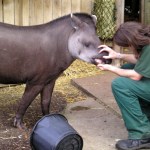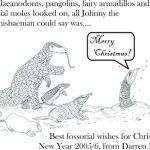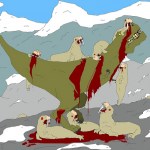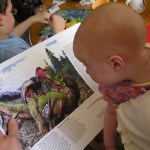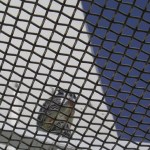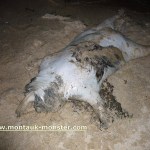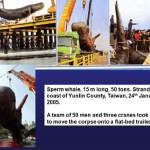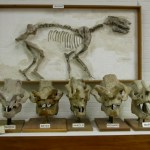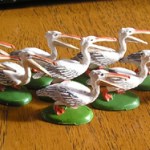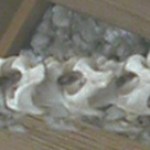frivolous nonsense
I received some really nice cards for my birthday last week. But this has to be my favourite... (oh, after the one from the kids of course)...
I mean, how often do you see Balaeniceps rex on a birthday card? Not often enough in my view (with a nod to those who have a phobia of this daunting bird). The image is by Elizabeth Diggins. Thank you Tina!
After all that talk of tapirs biting people's arms off and killing Brazilian farmers, it only seems appropriate to post these pictures, taken at Bristol Zoo on Sunday (a group of us went there after SVP). The keeper obviously has a great relationship with Denzil, the male Brazilian (or Lowland) tapir Tapirus terrestris on the right (the female, on the left, is called Tamang)...
As for Meller's duck Anas melleri - a species you'll now be very familiar with - I find that they do not hesitate to attack humans, should the opportunity arise...
Still working hard to catch up after SVP, still…
I'm somewhat pushed for time at the moment (massive, massive understatement), so nothing new here, sorry. Too busy with book jobs, SVP preparation, demolition work, baby care and other stuff. So here's some nonsense: if you've been with me from the start you'll remember this captivating image from January 2006. To the rest of you it might be new. Believe it or don't it's Fig. 2 in the Tet Zoo book (currently nearing completion, after a hiatus of more than a year).
In other news: the thing everyone's talking about today is the launch of the Open Dinosaur Project. This ambitious project aims,…
Yeah, what the hell, what have I got to lose, what's the worse that could happen, and other such platitudes... I finally decided, after an annoying number of prompts and requests and so on, to join the time-sucking black hole of frivolity that is Facebook. Thus far I've used it to piss around and post pictures like those below - but isn't that what it's for?
Apparently it can serve some of useful purpose, but I'm sure I'll get to that eventually. If I slowly start to lose interest in the blogosphere, you'll know why. And if you want to know who to blame: Max Blake, j'accuse.
Neil 'where the fudge are my thalattosaurs' Kelley once brought my attention to the following piece of art...
I thought about saying something intelligent, but decided not to.
UPDATE: the image comes from here: Valin Mattheis's flickr site, and I hope I'm ok in using it.
Back in April 2008 (my god - where does the time go?) I wrote a brief article about the Animal Life and The Private Lives of Animals books, published by Casa Editrice AMZ. These first came out during the late 1960s and were written in Italian; they were then translated into English during the 70s. As I said last year, the art in these books is generally pretty fantastic and a joy to look it. However, the artists were, evidently, sometimes asked to paint things that they'd never seen (example: the sexual dimorphism present in Sable antelopes Hippotragus niger).
What also makes the books…
On the way out last night (happy birthday Dad!) we drove past a dead hedgehog at the side of the road. A not uncommon sight, I'm sorry to say. The good news is that the body was still there today, so - naturally - I went and collected it. So, finally, I have a whole, intact hedgehog in my collection. I'll have more news on its development into a skeletonised study specimen in months to come...
As you can see, this individual was HUGE (though not the largest hedgehog I've ever seen).
For previous Tet Zoo articles on dead bodies and what to do with them, see...
The Bere Regis polecat corpse…
For millenia, a battle has raged between alligators and water melons. Who will win? Well, the answer's obvious: one has a bite force of over 15,000 Newtons, and the other one's a water melon. Yes, the alligator vs water melon craze has gone mainstream, as testified by its appearance on Sky News... though, god help them, they managed to mistake an alligator for a crocodile. Hopeless. Anyway...
It's gratifying and amusing to see an alligator destroy a water melon with such devastating ease [for more information, see the accompanying text at youtube]. But there are a few other things of interest…
Here's a recent photo showing the proofs of one of my books. These particular pages (which focus on the 'dinosaur renaissance' of the 1960s and 70s) feature a Luis Rey piece: as usual, poor Tenontosaurus is getting dispatched by a Deinonychus gang. As you can see, Emma thought the picture looked neat (Will plays with Lego power miners in the background. The photo has already been featured here at Querencia)...
I sent the photo round to a few friends. Comments so far have included "I think it's more she is querying the extent of feathering, surely?", "That is beautiful * you will get it…
Last weekend I went out, and saw this. What could it be?
Warning: this is not meant to be easy. Answer tomorrow.
Ever one to jump on a bandwagon, and with another 'mystery carcass' case still all too fresh on the Tet Zoo list of articles, I've decided to blog about this new 'Montauk monster' carcass. In case you've forgotten, back in July 2008 the global media went absolutely apeshit over a rotten raccoon carcass, informally dubbed the 'Montauk monster', and suggested by the uninformed to be some weird genetic experiment, a dead turtle without its shell (duh: THE SHELL IS THE RIBCAGE, IT CANNOT BE MAGICALLY DETACHED FROM THE REST OF THE BODY), or some sort of beaked dinosaur-monster. Yes, if you ever…
Here are assorted relevant things that happened in March: ahh, what a month. First of all, another sea monster. It's the famous fishy-crustaceany monster thing at Plymouth Hoe Barbican...
Here's a dead Mute swan Cygnus olor I found among all the rubbish during the Chessel Bay clean-up. I have its head.
And here's a dead female Bullfinch Pyrrhula pyrrhula a friend gave me. Why do finches so often have those big callouses on their feet? Is this the same thing as the bumblefoot infection that sometimes affects captive birds? Bullfinches are carduelines, most closely related to hawfinches and…
.... but the whale had been sitting around, decomposing, for several days...
Pity the person who came back to collect their parked scooter at the end of the day...
Here's a photo Matt Wedel took in the Raymond Alf Museum in Claremont, California. The lined-up skulls belong (I think) to Megacerops, the large to very large Late Eocene brontothere previously known as Brontotherium. Like most other brontotheriine brontotheres it has reduced, globular upper incisors and is very wide at the back of the skull. The upper incisors were in fact so small that they might have been virtually useless, and these animals probably relied on a prehensile lip to gather food. Must stop there - want to start talking about horns and evidence for intraspecific combat, but…
No time. Too busy. Toy pelicans from Marwell Zoo. Accompanying thoughts from Dave Hone here; involves azhdarchids. Bye now, sorry for lack of substantive content.
Those of you who notice such things might have wondered where I've been over the last few days: after all, I'm now pretty much in the habit of posting to Tet Zoo every day. I've been 'absent' due to internet problems (now resolved, for the time being at least)... though, yeah, I've got other excuses too. As a result, my plans have been temporarily derailed, but I'll try and get back to speed ASAP. Meanwhile, the adjacent image shows one of the things I've been busy with this week. Would like to tell you the whole story, but can't.
Let's have some fun. Try and identify this tetrapod: and you have to get it down to genus. Good luck.
It's not everyday that you discover a shop named after a group of fairly obscure amphibious lipotyphlans. While in Spain last year, I was intrigued by this shop...
I think it sold clothes or something, though frankly I don't recall checking. Here's a close-up of the animal featured on the signage...
Desmans are members of Talpidae (the same group that includes the moles), and there are only two extant species: the Russian desman Desmana moschata and Pyrenean desman Galemys pyrenaicus (there are loads of fossil species though, in about ten extinct genera). Both have a long, sensitive…
No time at the moment to complete anything for the blog, dammit. So only time for a picture of the day. Inspired by recent comments made here about the whereabouts of the Krayt dragon skeleton from Star Wars Episode IV: A New Hope, Matt Wedel has done a great job of both identifying the skeleton, and of tracking down its whereabouts. As he explains, palaeontologists have actually located the skeleton before (David Reynolds and Michael Ryan did so in 1995), and it was also 're-discovered' by the Lucasfilm people during the making of Episode II: The Clone Wars. Check out Matt's article on SV-…
Oh crap, it's 2009 already (one of my favourite lines from movies is: "They say time is the fire in which we burn". Quiz: where is it from?). Happy New Year! For no reason at all - other than that I'm reading a lot about seabirds at the moment - here is a neat photo of several Black-headed gulls Chroicocephalus ridibundus, taken by my good friend Tina Whitlock.
Chroicocephalus ridibundus is of course the bird that you probably know better as Larus ridibundus: if you missed the big bun-fight (reference) we had here at Tet Zoo about gull taxonomy - and indeed about taxonomy in general - go see…

